Water Use Efficiency in Saline Soils under Cotton Cultivation in the Tarim River Basin
Abstract
:1. Introduction
2. Materials and Methods
2.1. Site Description
| Site | Location | Temp (°C) | Prec (mm) | Ele (m) a.s.l. | GWD (m) | Relative Humidity a(%) | Wind Speed a(km·h−1) | Soil Type |
|---|---|---|---|---|---|---|---|---|
| Aksu | 40°37′ N 80°45′ E | 11.0 | 71.6 | 1028 | 2.0 | 50.5 | 5.3 | Solonchak |
| Korla | 41°35′ N 86°09′ E | 12.2 | 100.8 | 903 | 1.4 | 42.8 | 7.7 | Solonchak |
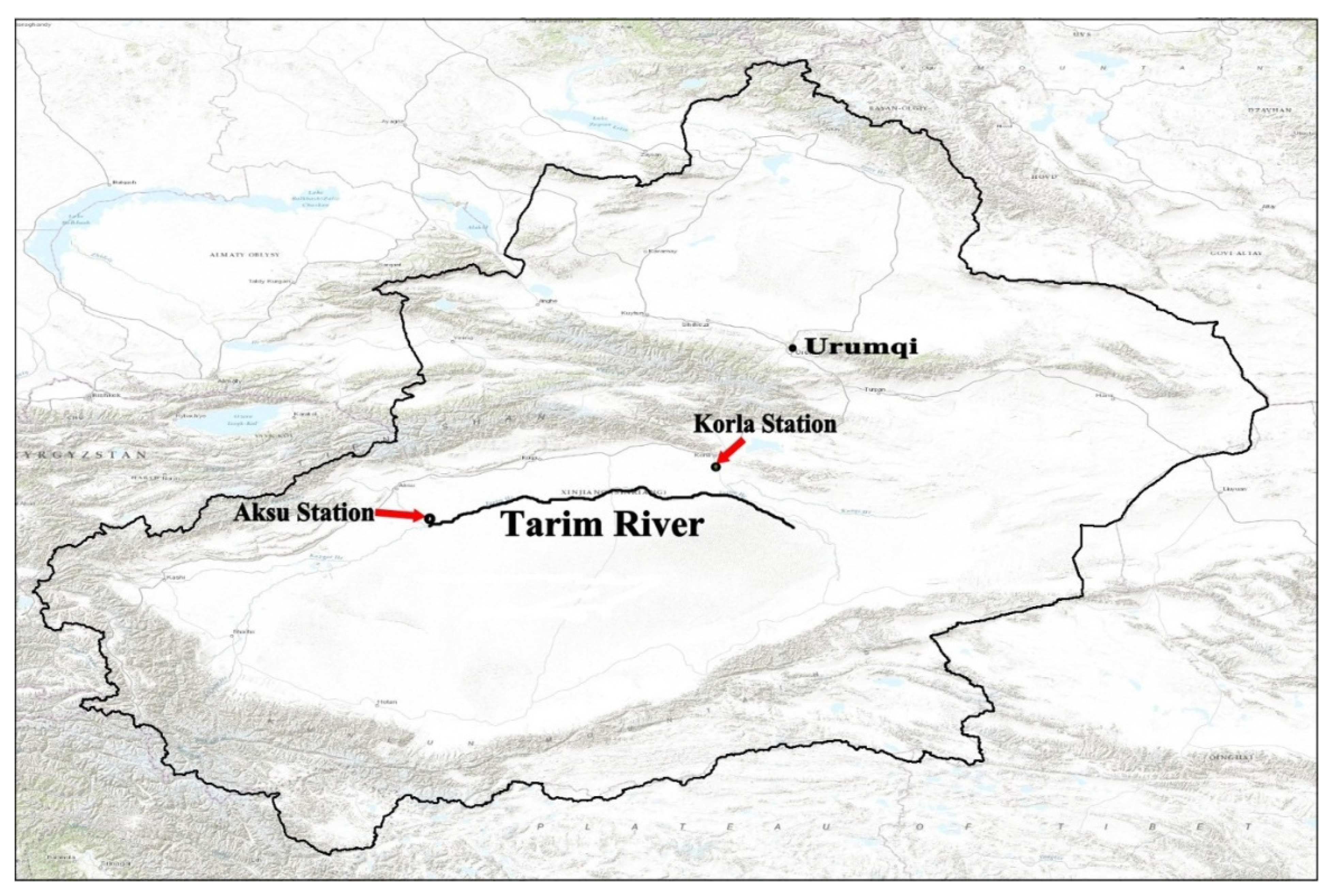
| Soil Salinity Level | Sample Depth | CEC | BD | pHH2O (1:5) | EC (1:5) | ECe | Corg | Ntot | CaCO3 | CO32− | HCO3− | Cl− | SO42− | Ca2+ | Mg2+ | Na+ | K+ | Partial Size Distribution | Soil Texture | |||
|---|---|---|---|---|---|---|---|---|---|---|---|---|---|---|---|---|---|---|---|---|---|---|
| Clay < 2 μm | Silt 2–63 μm | Sand 63–2000 μm | ||||||||||||||||||||
| (cm) | (cmol/kg) | (g/cm3) | (mS/cm) | (g/kg) 1 | (%) | |||||||||||||||||
| Low (17–25 mS·cm−1) | Low (Korla) | 27 | 2.9 | 1.57 | 7.8 | 1.7 | 23.8 | 4.8 | 1.1 | 116.1 | 0.00 | 0.2 | 0.2 | 2.1 | 0.8 | 0.2 | 0.2 | 0.1 | 2.6 | 38.1 | 59.3 | Sandy loam |
| 52 | 2.0 | 1.55 | 8.1 | 1.5 | 21.0 | 1.7 | 0.9 | 123.5 | 0.00 | 0.3 | 0.4 | 0.6 | 0.3 | 0.1 | 0.3 | 0.1 | 2.6 | 36.0 | 61.4 | Sandy loam | ||
| 63 | 1.5 | 1.50 | 8.2 | 1.5 | 21.0 | 1.6 | 0.9 | 120.7 | 0.00 | 0.2 | 0.2 | 0.9 | 0.4 | 0.1 | 0.2 | 0.1 | 2.0 | 27.2 | 70.8 | Loamy sand | ||
| 85 | 2.9 | 1.56 | 8.2 | 1.8 | 25.2 | 2.4 | 0.9 | 115.9 | 0.01 | 0.3 | 0.6 | 1.2 | 0.4 | 0.2 | 0.5 | 0.1 | 2.5 | 41.3 | 56.1 | Sandy loam | ||
| 120 | 1.2 | 1.50 | 8.5 | 1.2 | 16.8 | 1.5 | 0.9 | 111.1 | 0.01 | 0.3 | 0.2 | 0.4 | 0.2 | 0.1 | 0.2 | 0.1 | 1.7 | 21.3 | 77.0 | Loamy sand | ||
| 140 | 1.9 | 1.57 | 8.4 | 1.3 | 18.2 | 2.1 | 0.9 | 116.5 | 0.01 | 0.2 | 0.2 | 0.4 | 0.2 | 0.1 | 0.2 | 0.1 | 3.2 | 43.8 | 53.1 | Sandy loam | ||
| Low (Aksu) | 27 | 5.0 | 1.37 | 8.0 | 1.8 | 25.2 | 6.8 | 1.3 | 161.4 | 0.01 | 0.4 | 0.3 | 1.6 | 0.5 | 0.3 | 0.3 | 0.1 | 8.8 | 82.2 | 9.0 | Silt | |
| 38 | 7.4 | 1.54 | 8.2 | 1.4 | 19.6 | 8.7 | 1.4 | 157.1 | 0.00 | 0.4 | 0.2 | 0.7 | 0.3 | 0.1 | 0.2 | 0.1 | 6.8 | 75.2 | 18.0 | Silt loam | ||
| 64 | 6.1 | 1.51 | 8.1 | 1.5 | 21.0 | 8.2 | 1.4 | 159.8 | 0.00 | 0.4 | 0.2 | 0.8 | 0.3 | 0.2 | 0.2 | 0.1 | 8.2 | 77.0 | 14.7 | Silt loam | ||
| 130 | 1.7 | 1.33 | 8.3 | 1.2 | 16.8 | 2.1 | 0.9 | 67.1 | 0.00 | 0.3 | 0.2 | 0.3 | 0.2 | 0.1 | 0.1 | 0.1 | 2.1 | 71.1 | 26.8 | Silt loam | ||
| Middle (29–50 mS·cm−1) (Aksu) | 35 | 5.6 | 1.52 | 7.5 | 3.5 | 49.0 | 4.4 | 0.3 | 138.7 | 0.00 | 0.1 | 0.5 | 8.2 | 2.5 | 0.3 | 0.8 | 0.1 | 5.4 | 74.7 | 19.9 | Silt loam | |
| 67 | 1.8 | 1.42 | 7.5 | 3.6 | 50.4 | 1.5 | 0.1 | 94.8 | 0.00 | 0.1 | 1.0 | 8.1 | 2.9 | 0.1 | 0.9 | 0.0 | 2.6 | 51.1 | 46.3 | Silt loam | ||
| 104 | 5.5 | 1.40 | 7.9 | 2.1 | 29.4 | 2.2 | 0.2 | 161.7 | 0.00 | 0.2 | 0.8 | 1.4 | 0.3 | 0.1 | 0.7 | 0.0 | 3.6 | 70.8 | 25.5 | Silt loam | ||
| 130 | 4.8 | 1.48 | 7.9 | 1.6 | 22.4 | 2.1 | 0.1 | 170.6 | 0.00 | 0.2 | 0.2 | 1.2 | 0.2 | 0.1 | 0.3 | 0.0 | 4.5 | 75.1 | 20.4 | Silt loam | ||
| High (52–62 mS·cm−1) (Aksu) | 32 | 2.8 | 1.70 | 7.5 | 3.7 | 51.8 | 2.1 | 0.1 | 100.4 | 0.00 | 0.1 | 1.0 | 8.3 | 2.7 | 0.3 | 1.0 | 0.1 | 4.0 | 57.5 | 38.5 | Silt loam | |
| 57 | 2.8 | 1.71 | 7.6 | 4.1 | 57.4 | 1.5 | 0.1 | 108.5 | 0.00 | 0.1 | 1.7 | 8.9 | 2.9 | 0.3 | 1.5 | 0.1 | 4.7 | 68.5 | 26.8 | Silt loam | ||
| 85 | 3.8 | 1.39 | 7.6 | 4.4 | 61.6 | 1.8 | 0.1 | 107.9 | 0.00 | 0.1 | 2.1 | 8.8 | 2.8 | 0.3 | 1.9 | 0.0 | 5.1 | 74.6 | 20.3 | Silt loam | ||
| 110 | 3.9 | 1.49 | 7.5 | 4.3 | 60.2 | 1.7 | 0.1 | 138.1 | 0.00 | 0.1 | 1.9 | 8.5 | 2.8 | 0.2 | 1.8 | 0.0 | 6.7 | 81.7 | 11.6 | Silt | ||
| 115 | 4.1 | n.d. | 7.4 | 4.2 | 58.8 | 1.7 | 0.1 | 121.9 | 0.00 | 0.1 | 1.7 | 8.7 | 2.9 | 0.1 | 1.8 | 0.0 | 5.6 | 78.7 | 15.7 | Silt loam | ||
2.2. Experimental Design
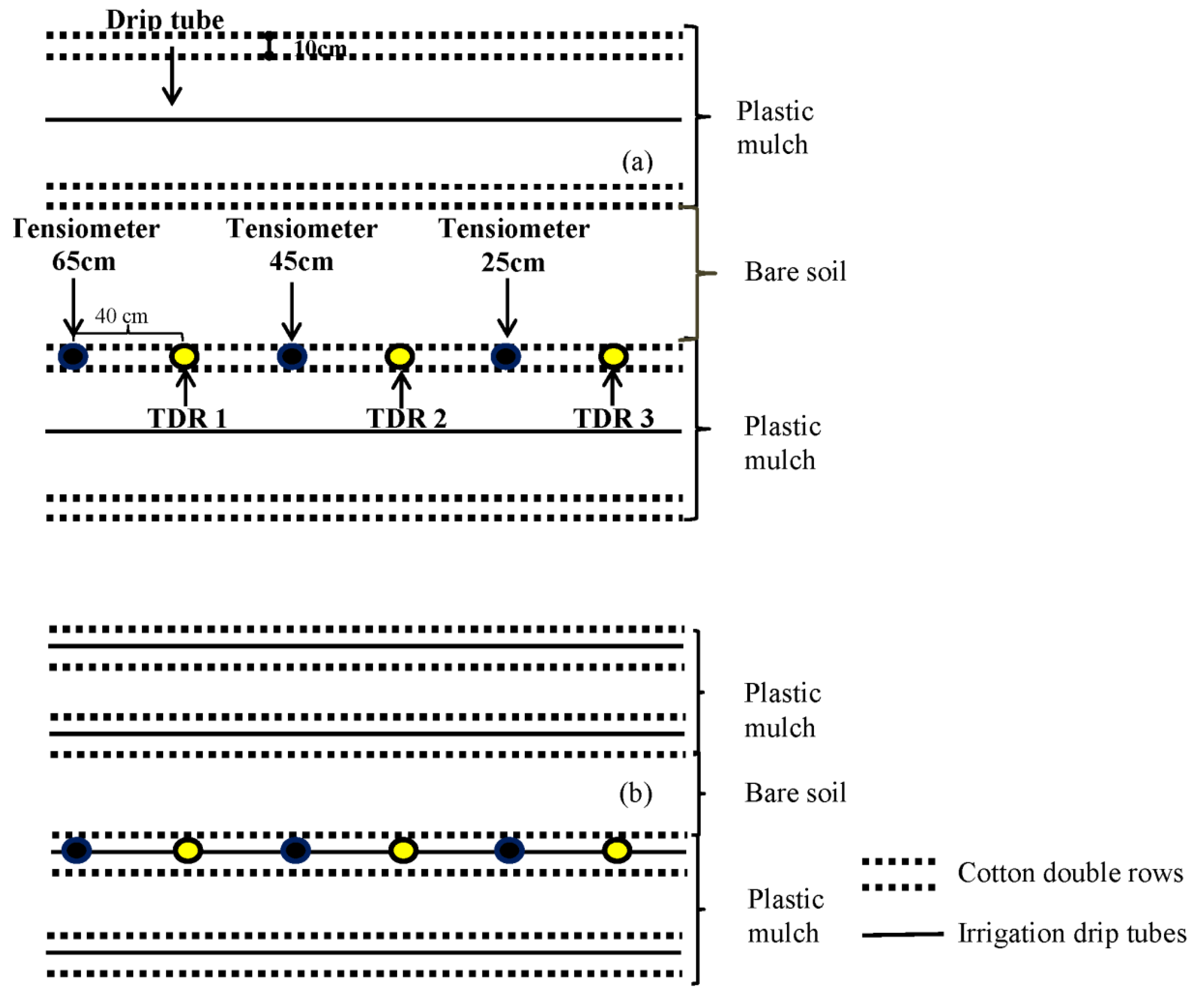
2.3. Field Sampling and Laboratory Analysis
2.4. Calculations and Statistical Analysis
2.4.1. Soil Water Retention
2.4.2. Water Use Efficiency (WUE)
2.4.3. Statistical Analysis
3. Results
3.1. Soil Chemical and Physical Properties of Different Saline Soils
3.2. Soil Water Retention in Different Saline Soils at Different Soil Depths
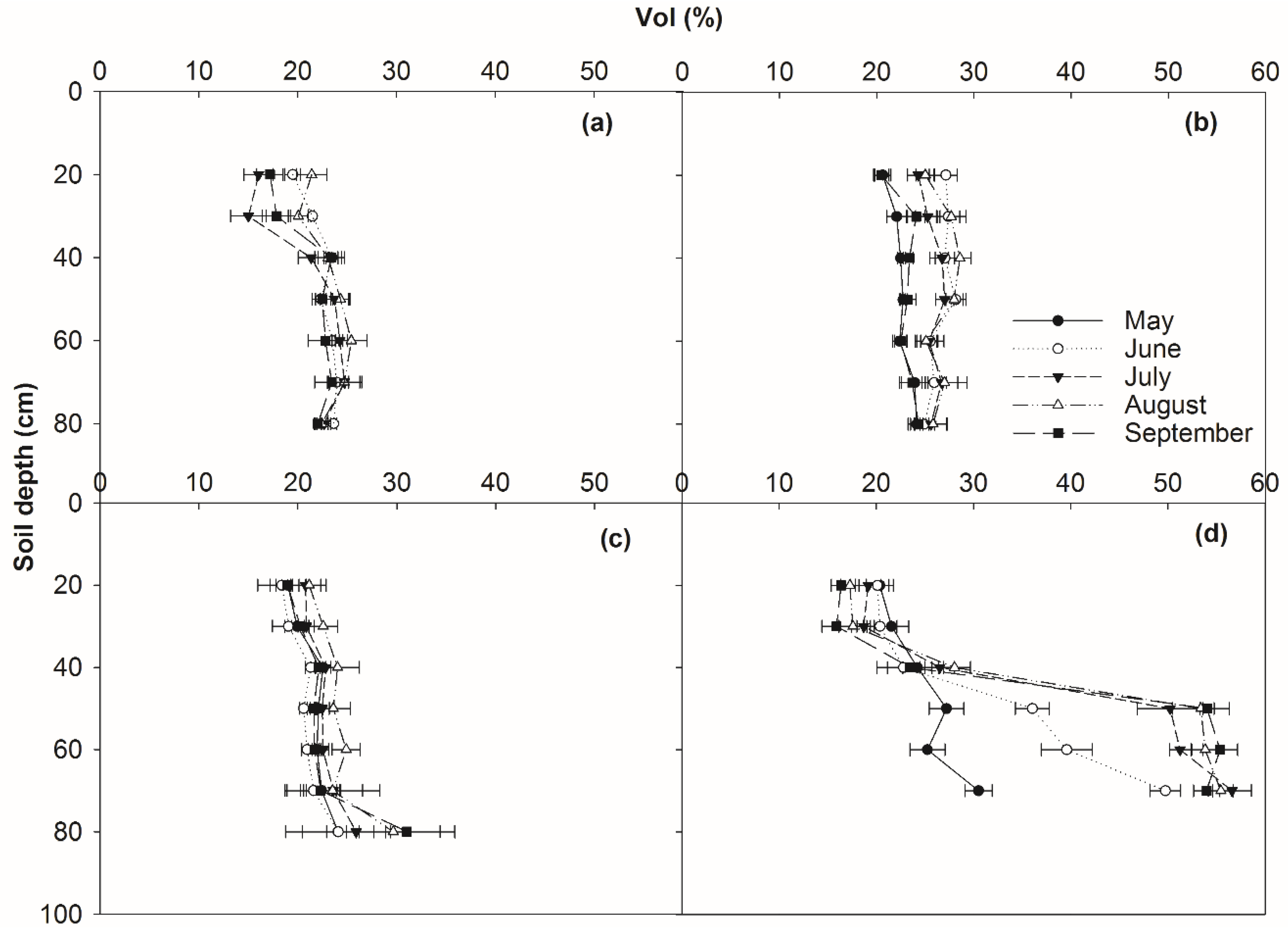
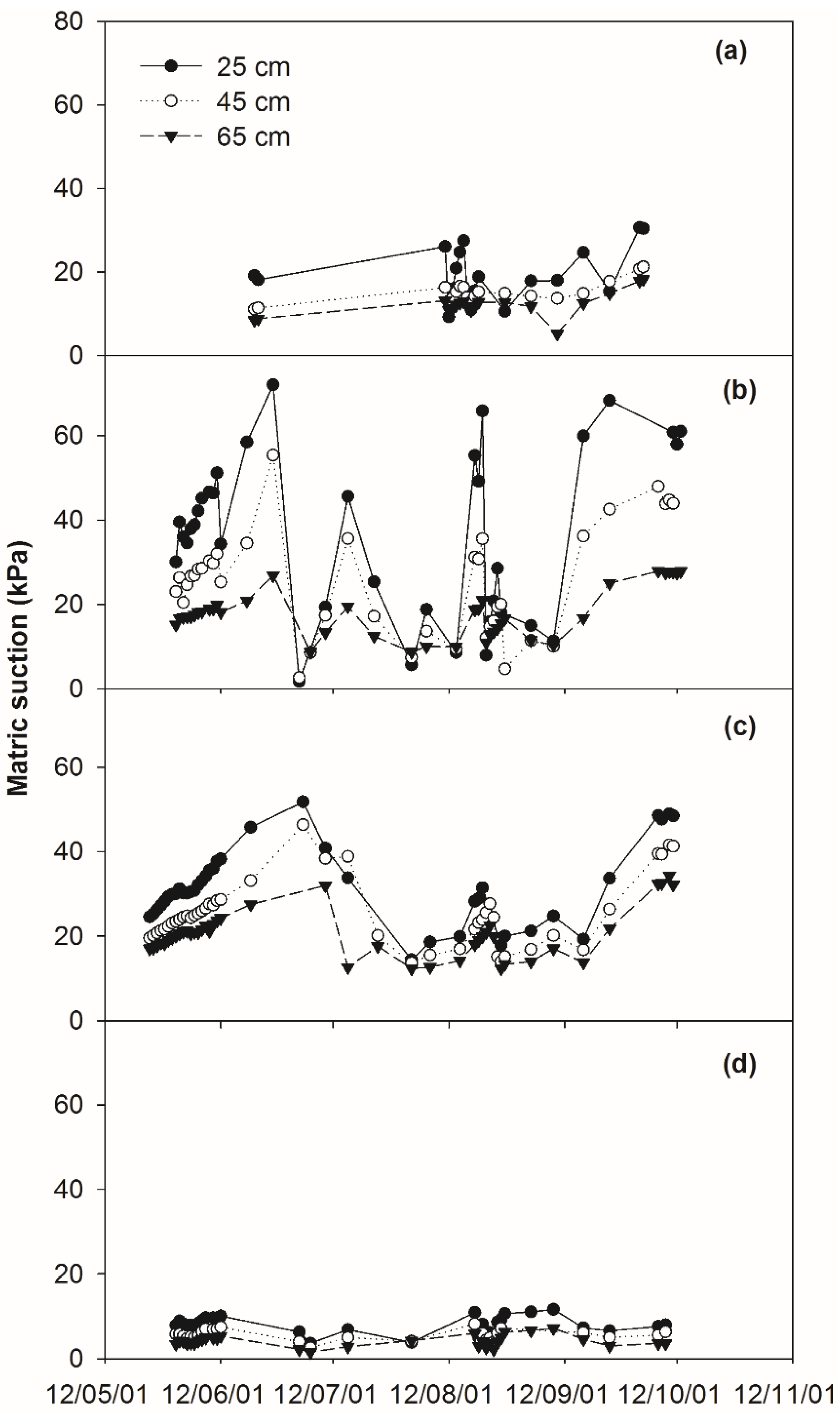
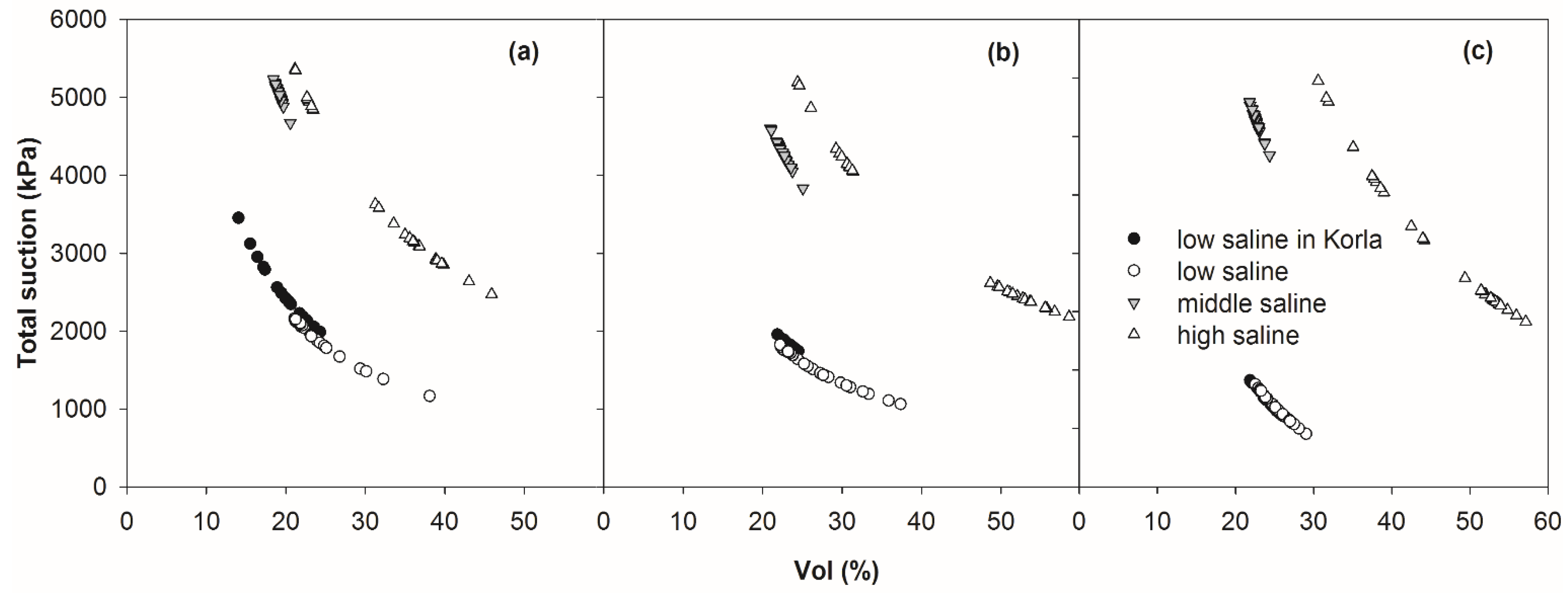
3.3. Water Use Efficiency in Different Saline Soils
| Location | Soil Salinity | Sowing | Harvest | Fert N | Fert P | Fert K | Irrigation 1 | Precipitation 1 | Yield 2 | IWUE | WUE |
|---|---|---|---|---|---|---|---|---|---|---|---|
| Level | Date | Date | (kg·ha−1) | (mm) | (mm) | (t·ha−1) | (kg·ha−1·mm−1) | ||||
| Korla | Low | 04.05 | 04.09 | 331 | 124 | 108 | 571 | 128 | 6.64 | 11.6 a | 9.5 a |
| Aksu | Low | 08.04 | 15.09 | 306 | 294 | 55 | 878 | 49 | 4.48 | 5.1 b | 4.8 b |
| Aksu | Middle | 25.04 | 10.09 | 317 | 88 | 135 | 878 | 49 | 4.68 | 5.3 b | 5.0 b |
| Aksu | High | 08.04 | 05.09 | 327 | 215 | 70 | 804 | 49 | 2.39 | 3.0 c | 2.8 c |
4. Discussion
4.1. Soil Water Retention in Relation to Different Soil Properties
4.2. Soil Water Retention Curves
4.3. Water Use Efficiency in Different Saline Soils
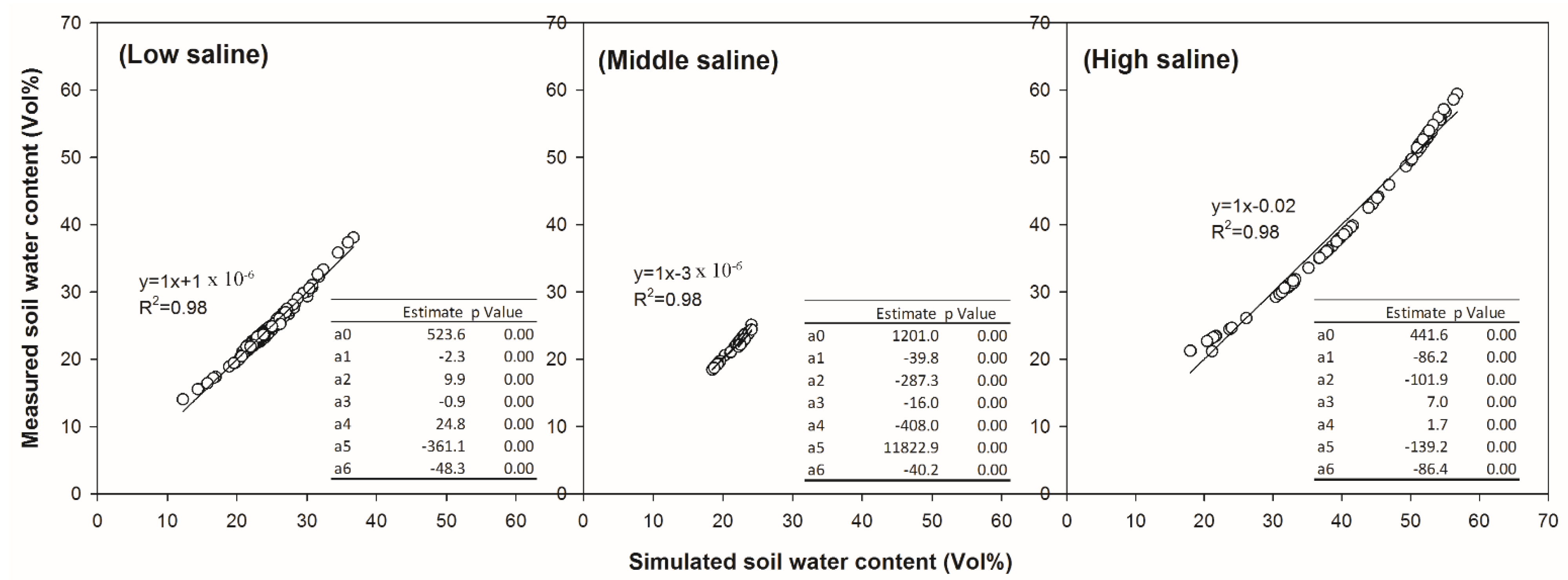
5. Conclusions
Acknowledgments
Author Contributions
Conflicts of Interest
References
- Hao, X.M.; Chen, Y.N.; Li, W.H. Impact of anthropogenic activities on the hydrologic characters of the mainstream of the Tarim River in Xinjiang during the past 50 years. Environ. Geol. 2009, 57, 435–445. [Google Scholar] [CrossRef]
- Qi, F.; Wei, L.; Jianhua, S.; Yonghong, S.; Yewu, Z.; Zongqiang, C.; Haiyang, X. Environmental effects of water resource development and use in the tarim river basin of Northwestern China. Environ. Geol. 2005, 48, 202–210. [Google Scholar] [CrossRef]
- Feng, Q.; Liu, W. Environmental conditions leading to the formation of holocene soil layers in the Northern Taklimakan Desert, Tarim Basin, Northwest China. Geol. J. 2005, 40, 23–34. [Google Scholar] [CrossRef]
- Feng, Q.; Cheng, G.D.; Masao, M.K. Trends of water resource development and in arid North-West China. Environ. Geol. 2000, 39, 831–838. [Google Scholar] [CrossRef]
- Chen, X.B.; Yang, J.S.; Liu, C.Q.; Hu, S.J. Soil salinization under integrated agriculture and its countermeasures in Xinjing (in Chinese with English abstract). Soils 2007, 39, 347–353. [Google Scholar]
- Hou, Z.A.; Wang, H.Y.; Gong, J.; Xiao, L.; Ma, L.; Qi, T. Salt distribution and accumulation as affected by under-film drip irrigation with saline water in an arid region (in Chinese with English abstract). Chin. J. Soil Sci. 2008, 39, 16–24. [Google Scholar]
- Chen, Y.; Ye, Z.; Shen, Y. Desiccation of the tarim river, xinjiang, china, and mitigation strategy. Quatern. Int. 2011, 244, 264–271. [Google Scholar] [CrossRef]
- Zhang, X.Y.; Cai, H.J. Effects of regulatd deficit irrigation on plastic effect-mulched cotton (in Chinese with English abstract). J. Northwest Sci. Tech. Univ. Agric. For. 2001, 29, 9–12. [Google Scholar]
- Wang, C.R.; Tian, X.H.; Li, S.H. Effects of plastic sheet-mulching on ridge for water-harvesting cultivation on wue and yield of winter heat. Sci. Agric. Sin. 2004, 37, 208–214. [Google Scholar]
- Hu, X.T.; Chen, H.; Wang, J.; Meng, X.B.; Chen, F.H. Effects of soil water content on cotton root growth and distribution under mulched drip irrigation (in Chinese with English abstract). Agric. Sci. China 2009, 8, 709–716. [Google Scholar] [CrossRef]
- Hu, S.; Song, Y.; Zhou, H.; Tian, C. Experimental study on water use efficiency of cotton in the tarim river basin. Agric. Res. Arid Areas 2002, 20, 66–70. [Google Scholar]
- Kang, Y.; Wang, R.; Wan, S.; Hu, W.; Jiang, S.; Liu, S. Effects of different water levels on cotton growth and water use through drip irrigation in an arid region with saline ground water of Northwest China. Agric. Water Manag. 2012, 109, 117–126. [Google Scholar] [CrossRef]
- Zhao, C.Y.; Sheng, Y.; Yimam, Y. Quantifying the impacts of soil water stress on the winter wheat growth in an arid region, Xinjiang. J. Arid Land 2009, 1, 34–42. [Google Scholar]
- Zhao, C.Y.; Yan, Y.Y.; Yimamu, Y.; Li, J.Y.; Zhao, Z.M.; Wu, L.S. Effects of soil moisture on cotton root length density and yield under drip irrigation with plastic mulch in aksu oasis farmland. J. Arid Land 2010, 2, 243–249. [Google Scholar]
- Dong, H.; Li, W.; Tang, W.; Zhang, D. Early plastic mulching increases stand establishment and lint yield of cotton in saline fields. Field Crop Res. 2009, 111, 269–275. [Google Scholar] [CrossRef]
- Wang, R.; Kang, Y.; Wan, S.; Hu, W.; Liu, S.; Jiang, S.; Liu, S. Influence of different amounts of irrigation water on salt leaching and cotton growth under drip irrigation in an arid and saline area. Agric. Water Manag. 2012, 110, 109–117. [Google Scholar] [CrossRef]
- Chen, X.B.; Yang, J.S.; Zhang, F.D.; Hu, S.J.; Li, H. Control of soil water salinity variatons based on crop-salt-water production function in Tarim irrigation area (in Chinese with English abstract). J. Irrig. Drain. 2007, 26, 75–78. [Google Scholar]
- Liu, M.X.; Yang, J.S.; Li, X.M.; Yu, M.; Wang, J. Effects of irrigation water quality and drip tape arrangement on soil salinity, soil moisture distribution, and cotton yield (gossypium hirsutum l.) under mulched drip irrigation in Xinjiang, China. J. Integr. Agric. 2012, 11, 502–511. [Google Scholar] [CrossRef]
- Ma, D.; Wang, Q.; Lai, J. Field experimental studies on the effects of water quality and drip rate on soil salt distribution in drip irrigation under film. Trans. Chin. Soc. Agric. Eng. 2005, 21, 42–46. (In Chinese) [Google Scholar]
- Thomsen, I.K.; Schjønning, P.; Jensen, B.; Kristensen, K.; Christensen, B.T. Turnover of organic matter in differently textured soils. II. Microbial activity as influenced by soil water regimes. Geoderma 1999, 89, 199–218. [Google Scholar] [CrossRef]
- Chen, M.; Kang, Y.; Wan, S.; Liu, S.P. Drip irrigation with saline water for oleic sunflower (helianthus annuus l.). Agric. Water Manag. 2009, 96, 1766–1772. [Google Scholar] [CrossRef]
- Kang, Y.; Wan, S. Effect of soil water potential on radish (raphanus sativus l.) growth and water use under drip irrigation. Sci. Hortic. 2005, 106, 275–292. [Google Scholar] [CrossRef]
- Jiao, Y.P.; Kang, Y.H.; Wan, S.Q.; Liu, W. Effect of soil matric potential on waxy corn (zea mays l. Sinesis kulesh) growth and water use under drip irrigation in saline soils of arid areas. In Proceedings of the 8th International Dryland Development Conference, Beijing, China, 25–28 February 2006.
- Nimmo, J.R. Modeling structural influences on soil water retention. Soil Sci. Soc. Am. J. 1997, 61, 712–719. [Google Scholar] [CrossRef]
- Kironchi, G.; Kinyali, S.M.; Mbuvi, J.P. Environmental influence on water characteristics of soils in two semi-arid catchments in Laikipia, Kenia. Afr. Crop Sci. J. 1995, 3, 479–486. [Google Scholar]
- Pachepsky, Y.A.; Rawls, W.J. Soil structure and pedotransfer functions. Eur. J. Soil Sci. 2003, 54, 443–451. [Google Scholar] [CrossRef]
- Juhász, C.E.P.; Cooper, M.; Cursi, P.R.; Ketzer, A.O.; Toma, R.S. Savanna woodland soil micromorphology related to water retention. Sci. Agric. 2007, 64, 344–354. [Google Scholar] [CrossRef]
- Hollis, J.M.; Jones, R.J.A.; Palmer, R.C. The effects of organic matter and particle size on the water-retention properties of some soils in the west midlands of England. Geoderma 1977, 17, 225–238. [Google Scholar] [CrossRef]
- Rawls, W.J.; Pachepsky, Y.A.; Ritchie, J.C.; Sobecki, T.M.; Bloodworth, H. Effect of soil organic carbon on soil water retention. Geoderma 2003, 116, 61–76. [Google Scholar] [CrossRef]
- Reeve, M.J.; Smith, P.D.; Thomasson, A.J. The effect of density on water retention properties of field soils. J. Soil Sci. 1973, 24, 355–367. [Google Scholar] [CrossRef]
- Walczak, R.T.; Moreno, F.; Sławiński, C.; Fernandez, E.; Arrue, J.L. Modeling of soil water retention curve using soil solid phase parameters. J. Hydrol. 2006, 329, 527–533. [Google Scholar] [CrossRef]
- Abrol, I.P.; Khosla, B.K.; Bhumbla, D.R. Relationship of texture to some important soil moisture constants. Geoderma 1968, 2, 33–39. [Google Scholar] [CrossRef]
- Tutiempo. Global Climate Data. Available online: http://www.tutiempo.net/en/Climate/ (accessed on 1 January 2014).
- Lu, R.K. Soil Agricultural Chemical Analysis; Beijing Agricultural Technology press: Beijing, China, 1983. (In Chinese) [Google Scholar]
- The Ministry of Agriculture of People’s Republic of China. The Notification of Cotton Yield Calculation. 2010. Available online: http://www.moa.gov.cn/govpublic/ZZYGLS/201008/t20100816_1619412.htm (accessed on 1 January 2013). (In Chinese)
- Campbell, G.S. Soil water potential measurement: An overview. Irrig. Sci. 1988, 9, 265–273. [Google Scholar] [CrossRef]
- Or, D.; Wraith, J.M. Soil water content and water potential relationships. In Handbook of Soil Science; CRC press: Boca Raton, FL, USA, 2000; pp. A53–A85. [Google Scholar]
- Rengasamy, P. Soil salinity and sodicity. In Growing Crops with Reclaimed Wastewater; Inkata press: Melbourne, Australia, 2006; pp. 125–138. [Google Scholar]
- Regional Salinity, L. Diagnosis and Improvement of Saline and Alkali Soils; U.S. Department of Agriculture: Washington, DC, USA, 1954.
- Hu, S.; Shen, Y.; Chen, X.; Gan, Y.; Wang, X. Effects of saline water drip irrigation on soil salinity and cotton growth in an oasis field. Ecohydrology 2013, 6, 1021–1030. [Google Scholar] [CrossRef]
- Zhang, Y.; Wang, L.H.; Sun, S.M.; Chen, X.L.; Liang, Y.J.; Hu, S.J. Indexes of salt tolerance of cotton in akesu river irrigation destrict (in Chinese with English abstract). Sci. Agric. Sin. 2011, 44, 2051–2059. [Google Scholar]
- Yadav, S.; Irfan, M.; Ahmad, A.; Hayat, S. Causes of salinity and plant manifestations to salt stress: A review. J. Environ. Biol. 2011, 32, 667–685. [Google Scholar] [PubMed]
- Wang, Z.; Jin, M.; Šimůnek, J.; van Genuchten, M.T. Evaluation of mulched drip irrigation for cotton in arid Northwest China. Irrig. Sci. 2014, 32, 15–27. [Google Scholar] [CrossRef]
- Zhang, N.; Zhao, Y.S.; Yu, G.R. Simulated annual carbon fluxes of grassland ecosystems in extremely arid conditions. Ecol. Res. 2009, 24, 185–206. [Google Scholar] [CrossRef]
- Wang, R.; Kang, Y.; Wan, S. Effects of different drip irrigation regimes on saline–sodic soil nutrients and cotton yield in an arid region of Northwest China. Agric. Water Manag. 2015, 153, 1–8. [Google Scholar] [CrossRef]
- Danierhan, S.; Shalamu, A.; Tumaerbai, H.; Guan, D. Effects of emitter discharge rates on soil salinity distribution and cotton (gossypium hirsutum l.) yield under drip irrigation with plastic mulch in an arid region of Northwest China. J. Arid Land 2013, 5, 51–59. [Google Scholar] [CrossRef]
- Min, W.; Guo, H.; Zhou, G.; Zhang, W.; Ma, L.; Ye, J.; Hou, Z. Root distribution and growth of cotton as affected by drip irrigation with saline water. Field Crop Res. 2014, 169, 1–10. [Google Scholar] [CrossRef]
- Deng, Z.; Bei, D.; Zou, G.L.; Cong, J.; Li, Y.; Cai, J.M.; Feng, J.J. Effects of water and nitrogen regulation on the yield and water and nitrogen use efficiency of cotton in South Xinjiang, Northwest China under plastic mulched drip irrigation. Chin. J. Appl. Ecol. 2013, 24, 2525–2532. [Google Scholar]
- Dai, J.; Dong, H. Intensive cotton farming technologies in China: Achievements, challenges and countermeasures. Field Crop Res. 2014, 155, 99–110. [Google Scholar] [CrossRef]
- Zheng, Z.; Zhang, F.; Ma, F.; Chai, X.; Zhu, Z.; Shi, J.; Zhang, S. Spatiotemporal changes in soil salinity in a drip-irrigated field. Geoderma 2009, 149, 243–248. [Google Scholar] [CrossRef]
- Jeong, S.; Kim, J.; Lee, K. Effect of clay content on well-graded sands due to infiltration. Eng. Geol. 2008, 102, 74–81. [Google Scholar] [CrossRef]
- Horn, R.; Taubner, H.; Wuttke, M.; Baumgartl, T. Soil physical properties related to soil structure. Soil Tillage Res. 1994, 30, 187–216. [Google Scholar] [CrossRef]
- Wang, R.; Kang, Y.; Wan, S.; Hu, W.; Liu, S.; Liu, S. Salt distribution and the growth of cotton under different drip irrigation regimes in a saline area. Agric. Water Manag. 2011, 100, 58–69. [Google Scholar] [CrossRef]
- Bassil, E.S.; Kaffka, S.R. Response of safflower (carthamus tinctorius l.) to saline soils and irrigation i. Consumptive water use. Agric. Water Manag. 2002, 54, 67–80. [Google Scholar] [CrossRef]
- Bassil, E.S.; Kaffka, S.R. Response of safflower (carthamus tinctorius l.) to saline soils and irrigation ii. Crop response to salinity. Agric. Water Manag. 2002, 54, 81–92. [Google Scholar] [CrossRef]
- Kang, Y.; Wang, F.X.; Liu, H.J.; Yuan, B.Z. Potato evapotranspiration and yield under different drip irrigation regimes. Irrig. Sci. 2004, 23, 133–143. [Google Scholar] [CrossRef]
- Schimel, J.; Balser, T.C.; Wallenstein, M. Microbial stress-response physiology and its implications for ecosystem function. Ecology 2007, 88, 1386–1394. [Google Scholar] [CrossRef] [PubMed]
- Setia, R.; Marschner, P.; Baldock, J.; Chittleborough, D.; Smith, P.; Smith, J. Salinity effects on carbon mineralization in soils of varying texture. Soil Biol. Biochem. 2011, 43, 1908–1916. [Google Scholar] [CrossRef]
- Chowdhury, N.; Nakatani, A.S.; Setia, R.; Marschner, P. Microbial activity and community composition in saline and non-saline soils exposed to multiple drying and rewetting events. Plant Soil 2011, 348, 103–113. [Google Scholar] [CrossRef]
- Tang, L.-S.; Li, Y.; Zhang, J. Biomass allocation and yield formation of cotton under partial rootzone irrigation in arid zone. Plant Soil 2010, 337, 413–423. [Google Scholar] [CrossRef]
- Nightingale, H.I.; Davis, K.R.; Phene, C.J. Trickle irrigation of cotton: Effect on soil chemical properties. Agric. Water Manag. 1986, 11, 159–168. [Google Scholar] [CrossRef]
- Mai, W.X.; Tian, C.Y.; Li, C.J. Soil salinity dynamics under drip irrigation and mulch film and their effects on cotton root length. Commun. Soil Sci. Plan 2013, 44, 1489–1502. [Google Scholar] [CrossRef]
- Luo, H.H.; Tao, X.P.; Hu, Y.Y.; Zhang, Y.L.; Zhang, W.F. Response of cotton root growth and yield to root restriction under various water and nitrogen regimes. J. Plant Nutr. Soil Sci. 2015. [Google Scholar] [CrossRef]
- Shan, X.Z.; Wei, Y.Q.; Yang, H.J.; Liu, J.F.; Zhang, R. The modelling research on the effect of soil organic carbon content on the soil water and salt movement (in Chinese with English abstract). Soil and Fertilizer. 1996, 5, 1–5. [Google Scholar]
- Kahlown, M.A.; Azam, M. Effect of saline drainage effluent on soil health and crop yield. Agric. Water Manag. 2003, 62, 127–138. [Google Scholar] [CrossRef]
© 2015 by the authors; licensee MDPI, Basel, Switzerland. This article is an open access article distributed under the terms and conditions of the Creative Commons Attribution license (http://creativecommons.org/licenses/by/4.0/).
Share and Cite
Zhao, X.; Othmanli, H.; Schiller, T.; Zhao, C.; Sheng, Y.; Zia, S.; Müller, J.; Stahr, K. Water Use Efficiency in Saline Soils under Cotton Cultivation in the Tarim River Basin. Water 2015, 7, 3103-3122. https://doi.org/10.3390/w7063103
Zhao X, Othmanli H, Schiller T, Zhao C, Sheng Y, Zia S, Müller J, Stahr K. Water Use Efficiency in Saline Soils under Cotton Cultivation in the Tarim River Basin. Water. 2015; 7(6):3103-3122. https://doi.org/10.3390/w7063103
Chicago/Turabian StyleZhao, Xiaoning, Hussein Othmanli, Theresa Schiller, Chengyi Zhao, Yu Sheng, Shamaila Zia, Joachim Müller, and Karl Stahr. 2015. "Water Use Efficiency in Saline Soils under Cotton Cultivation in the Tarim River Basin" Water 7, no. 6: 3103-3122. https://doi.org/10.3390/w7063103
APA StyleZhao, X., Othmanli, H., Schiller, T., Zhao, C., Sheng, Y., Zia, S., Müller, J., & Stahr, K. (2015). Water Use Efficiency in Saline Soils under Cotton Cultivation in the Tarim River Basin. Water, 7(6), 3103-3122. https://doi.org/10.3390/w7063103







